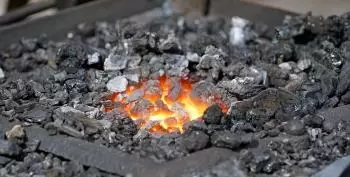
Coal is a metamorphic rock of organic origin. Its thermodynamic properties allow obtaining a large amount of heat energy during its combustion process. Therefore, it is a type of fossil fuel.
The energy obtained through its combustion is called fossil energy. It has a high calorific value due to its high carbon content.
The massive exploitation of coal gave rise to the Industrial Revolution as fuel for steam engines. However, the widespread combustion of coal, oil, or natural gas generates tons of greenhouse gases such as carbon dioxide. A big part of global warming is due to the amount of carbon dioxide emitted into the atmosphere and the products of coal chemical production.
The major countries by coal production are China, India, Indonesia, the United States, Australia, Russia, and South Africa.
Is coal renewable or non-renewable?
Coal is a non-renewable energy source because it is a limited natural resource.
The generation of this mineral is a process of several million years, while the consumption of this energy resource is high-speed. For this reason, it is considered a non-renewable energy source.
From where does coal come?
The origin of the coal can be vegetable or mineral:
-
Mineral coal is formed by a physical-chemical process of millions of years and is obtained from the mining industry from coal deposits under the subsoil.
-
Charcoal is produced by heating some materials (especially wood) to temperatures between 400 and 700°C with very little oxygen.
Fossil carbon was formed from ancient plant parts, especially during the Carboniferous period. Over time, these compounds became buried in the Earth's inner layers. The conditions of lack of oxygen, heat, and pressure for millions of years triggered a physical and chemical transformation until reached the formation of coal we know today.
What types of coal are there?
Coal is classified according to flammability, calorific value, percentage of non-combustible materials, and humidity.
The most used classification for international trade is lignite, sub-bituminous, bituminous, and anthracite.
European coal classification
However, the European classification is based on the percentage of carbon it contains:
-
Peat (50 to 55%)
-
Lignite (55 to 75%): Lignite coal is formed by compression of peat, and it still has traces of the original plants. It has high moisture content and a low heating value.
-
Subbituminous coal or Black Lignite
-
Coal (75 to 90%)
-
Anthracite (90 to 95%): the one with the highest proportion of carbon and the highest calorific value.
-
Graphite is pure carbon, and this variety is not used as fuel.
What is coal used for?
The two most widespread uses of coal are:
-
First, burning coal is the primary source of heat in industrial boilers.
-
To obtain electricity in thermal power plants.
75% of the world's coal is used to produce electricity in thermal power plants. However, the overall energy efficiency of coal plants is not very high, around 25%-27%.
Thermal power plants work from a heat source that generates steam. With the steam pressure, a turbine connected to an electric generator is activated. Later, this system was adapted to generate electricity using nuclear energy as a heat source.
Coal also has other more minor uses, among which are, for example, cement kilns and the production of coking coal from coal to produce steel.
What is the composition of the coal?
Coal is a sedimentary rock made up of:
-
Organic elements. In a majority proportion.
-
Mineral substances.
-
Water. Humidity is variable and comes from the one trapped in its formation.
-
Gases. Located in submicroscopic pores.
The carbon element appears in a percentage greater than 50% by weight and 70% by volume.
The composition and structure of an element transformed into carbon depend on the particular process of carbogenesis that it has undergone. In this sense, reference is made to its petrographic composition for the characterization of coal. The petrographic composition is the proportion and distribution of its respective macerals and constituent minerals.
In this way, for example, humic and sapropelic coals are distinguished.
The humic compounds are mainly made of vitrinite and give rise to the so-called ligno-coal or natural series (since most of the coals belong to it).
Methane gas
Methane is a gas found in coal mines and can be the source of dangerous explosions in underground mines. In this specific context, it is often called firedamp.
Gasification and liquefaction of coal
Two technologies with excellent prospects for the future are gasification and liquefaction of coal.
The first one is older; it was already used in the 18th century to obtain what was then called water gas. It is currently interested in producing synthetic finger gas fuels (synthetic natural gas, hydrogen, etc.). These gases are intended to be easier to store and transport and more environmentally friendly than solid coal.


